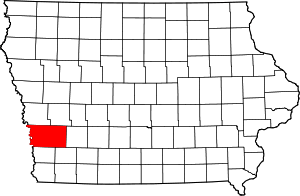B'nai Israel Synagogue (Council Bluffs, Iowa)
|
Chevra B'nai Yisroel Synagogue | |
|
| |
  | |
| Location |
618 Mynster St. Council Bluffs, Iowa |
|---|---|
| Coordinates | 41°15′52″N 95°51′9″W / 41.26444°N 95.85250°WCoordinates: 41°15′52″N 95°51′9″W / 41.26444°N 95.85250°W |
| Area | less than 1 acre |
| Built | 1931 |
| Architect | Jocheis Chris Jensen |
| Architectural style | Late 19th and early 20th century American Movements |
| NRHP Reference # | 07000113[1] |
| Added to NRHP | March 7, 2007 |
B'nai Israel Synagogue is a Reconstructionist synagogue located in Council Bluffs, Iowa, United States. It is listed on the National Register of Historic Places by its original name Chevra B'nai Yisroel Synagogue in 2007.
History
The first Jewish community in Council Bluffs was an Orthodox congregation in 1881 named Bikur Cholim. It had 25 charter members, but they had neither a rabbi nor a synagogue.[2] They held services in rented facilities. Chevra B’nai Yisroel Congregation was organized in 1903 with 14 adult male members. They acquired the present property and a built a frame synagogue the following year. On March 5, 1930 the building was destroyed in a fire. Members from the congregation saved the Torah, sacred scrolls, and other religious items.
A building committee was formed and plans were made for a new synagogue. Architect J. Chris Jensen was chosen to design the new building. The cornerstone from the former synagogue was recovered and was etched with an inscription for the new building. The new synagogue was completed on January 11, 1931. It seats 500 and was built for $26,000.[2] The congregation continued to grow and after World War II the congregation changed from Orthodox to Conservative Judaism. English was now used in services and men and women could now sit together. Previously the women and children sat in the balcony. The congregation officially changed its name to B'nai Israel in November 1953. An addition was designed by I.T. Carrithers in the early 1960s to add more space to the front and back of the older building. Only the back addition was built, however.
Soon after the addition was built the congregation began to decline in numbers. By 1980 plans were made to disband the congregation and sell the property. The membership, however, was determined to remain in place and recruited new members. In 1989 Rabbi Sharon Steifel became the first Reconstructionist rabbi at B'nai Israel.
Architecture
The exterior of the synagogue is covered in polychrome, rough-cast brick.[2] Classical entablature and galvanized iron cornice top the building. The building sits on a raised basement and the three doorways into the sanctuary are reached by a set of concrete steps. Inset panels of the Star of David and the tablets of the Ten Commandments inscribed in Hebrew are located above the doors. The interior is two-stories tall with a balcony, which had been reduced in size during the 1960s renovation. The congregation has seven Torahs, two of which were saved in the 1930 fire. The Ark is composed of dark wood paneling and classical pilasters. Louvered doors lead to the cabinet where its scrolls are kept.
References
- ↑ National Park Service (2009-03-13). "National Register Information System". National Register of Historic Places. National Park Service.
- 1 2 3 "Chevra B'nai Yisroel Synagogue, Council Bluffs, Pottawattamie County, Iowa". National Park Service. Retrieved 2012-02-11.
External links
B'nai Israel Synagogue website
